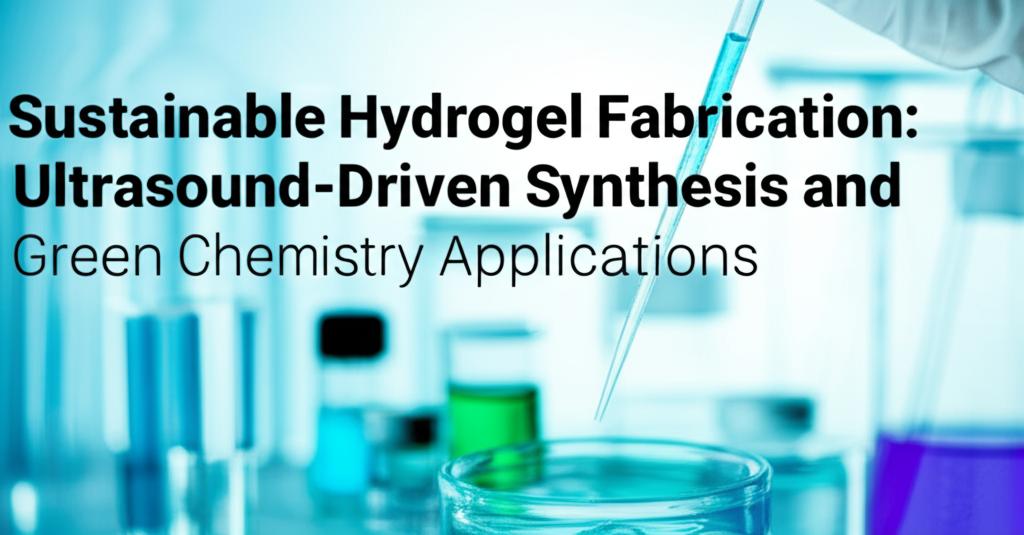The pursuit of sustainable and environmentally friendly materials has spurred significant advancements in hydrogel technology. Hydrogels, which are three-dimensional polymer networks capable of absorbing large quantities of water, are integral to numerous applications, including wound dressings, drug delivery, tissue engineering, soft robotics, and contact lenses. Traditionally, hydrogel synthesis has relied on chemical initiators, some of which can be toxic, posing risks to both human health and the environment. This has driven research towards greener and more efficient fabrication methods, with ultrasound-driven synthesis emerging as a promising alternative.
Ultrasound-Driven Synthesis: A Cleaner, Faster Approach
Recent breakthroughs have demonstrated the potential of ultrasound technology to revolutionize hydrogel fabrication. Researchers have pioneered a method that utilizes high-frequency sound waves to initiate the polymerization process, a technique dubbed "sonogel" technology. This approach eliminates the need for potentially harmful chemical initiators conventionally used to trigger the chemical chain reactions necessary for hydrogel formation.
The mechanism behind ultrasound-driven synthesis involves acoustic cavitation. When ultrasound waves propagate through the liquid precursor mixture containing hydrogel monomers, they induce the formation and collapse of microscopic gas bubbles. The violent collapse of these bubbles generates localized high energy, which is sufficient to initiate polymerization and form the hydrogel network.
This innovative method offers several distinct advantages:
- Speed and Efficiency: Ultrasound-driven hydrogel synthesis is significantly faster than traditional methods. While conventional techniques, such as those using UV light, can take hours or even overnight, sonogel formation can occur in as little as five minutes.
- Enhanced Safety and Sustainability: By eliminating toxic chemical initiators, this method is inherently safer for biomedical applications and more environmentally friendly. This aligns with the principles of green chemistry, which advocate for reducing or eliminating hazardous substances.
- Improved Material Properties: Hydrogels produced using ultrasound have been shown to exhibit superior properties. These "sonogels" are often stronger, more flexible, and demonstrate enhanced resistance to freezing and dehydration compared to conventionally synthesized hydrogels. This makes them more stable and durable for various applications.
- Controlled Gelation: Ultrasound offers precise control over the gelation process. This capability is particularly exciting for in-situ gelation, where a liquid precursor could be injected into the body and then solidified at a specific target site using focused ultrasound. This opens new avenues for non-invasive medical treatments, tissue repair, and regenerative medicine.
- Versatility in 3D Bioprinting: The precision of ultrasound could also be harnessed for advanced 3D bioprinting, allowing for the creation of complex hydrogel structures without relying on light or heat.
Green Chemistry in Hydrogel Development
The push for sustainability extends beyond ultrasound-driven synthesis and encompasses broader green chemistry principles in hydrogel development. This includes:
- Use of Natural Polymers: There is a growing emphasis on utilizing natural polymers derived from renewable resources such as plants (cellulose, starch, pectin, guar gum), algae (alginate), animals (collagen, gelatin, chitosan), or microorganisms (xanthan gum). These biopolymers are often biodegradable and biocompatible, reducing the environmental footprint of hydrogels. For example, cellulose, the most abundant natural polymer, and its derivatives are widely explored for creating eco-friendly hydrogels. Chitosan-based hydrogels are also gaining traction for their biodegradability and biocompatibility.
- Eco-Friendly Crosslinkers: Traditional crosslinking agents used to provide hydrogels with their network structure can be toxic. Green chemistry encourages the use of natural or less toxic crosslinkers. Examples include genipin (from gardenia fruit), tannic acid (from plant polyphenols), and citric acid (from citrus fruits).
- Sustainable Solvents and Processes: Efforts are underway to replace harsh organic solvents with greener alternatives like water or ionic liquids in hydrogel synthesis. Additionally, processes like photopolymerization, which uses light to initiate crosslinking, can be greener alternatives by avoiding chemical crosslinkers.
- Biodegradability and Recyclability: A key focus of green hydrogel development is ensuring that the materials are biodegradable or recyclable, minimizing waste and environmental pollution.
Applications and Future Directions
The combination of sustainable fabrication methods like ultrasound-driven synthesis and the incorporation of green chemistry principles is paving the way for a new generation of hydrogels with diverse and impactful applications:
- Biomedical Applications: The enhanced safety and improved properties of sustainably produced hydrogels are highly beneficial for medical uses. This includes advanced wound dressings that promote healing, sophisticated drug delivery systems with controlled release, scaffolds for tissue engineering and regenerative medicine (e.g., for repairing damaged tissues or organs), and bioadhesives. The potential for in-vivo gelation using ultrasound could revolutionize minimally invasive surgical procedures.
- Environmental Applications: Hydrogels can play a role in wastewater treatment by absorbing pollutants like heavy metals and dyes. In agriculture, they can improve water retention in soil, enhance crop yields, and enable the controlled release of fertilizers and pesticides, contributing to more sustainable farming practices.
- Wearable Electronics: Eco-friendly conductive hydrogels are being developed for green wearable electronics. These materials offer tissue-like properties, good electrical conductivity, stretchability, and biocompatibility, making them suitable for health monitors and biosensors that are in direct contact with the skin.
- Other Industries: Hydrogels find applications in various other sectors, including cosmetics, food products, and as superabsorbents in hygiene products.
The ongoing research and development in sustainable hydrogel fabrication are focused on further refining synthesis techniques, exploring new green materials, and expanding the range of applications. The overarching goal is to create high-performance hydrogels that are safe, effective, and environmentally responsible, contributing to a more sustainable future across multiple scientific and industrial domains. The continued advancement in areas like ultrasound-driven sono-fabrication promises to unlock even more innovative uses for these remarkable materials.

